Our trip to the Langhe region of Italy was a nice coincidence. We had heard about the area before, but hadn’t planned on visiting it anytime soon.
However, during the second wave of the pandemic in the autumn of 2020, we learned about a tourism voucher offered by the Piedmont Region to support the struggling tourism industry.
The voucher allowed us to get three nights for the price of one, with the other two nights being offered by the Region and the participating accommodation.
It ended up being a great long-term investment, as we took the trip about a year later.
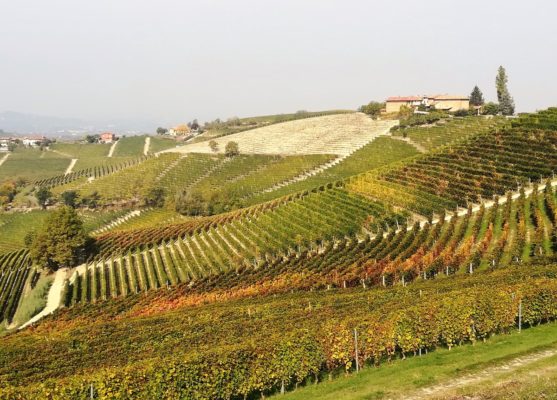
The Langhe landscape – near Treiso
After our stay, we can confidently say that the Langhe region is the perfect destination for travelers looking for an immersive, experiential holiday.
The area offers a range of activities, including visiting renowned wineries for wine tastings – anyone said Nebbiolo wine? -, participating in photography workshops and cooking classes, engaging in outdoor activities such as hiking or biking, and experiencing the local art and culture.
A diverse and rich mix of attractions and activities that will satisfy anyone wondering what to see and do in the Langhe.
Table of Contents
- Where are the Langhe
- Accommodation in the Langhe
- Best Time to Visit
- Langhe Wines
- Local Specialities
- A Trip to the Langhe, Best Things to Do
- What to See in the Langhe
Where are the Langhe
The Langhe area is located in the southern part of the Piedmont region, Italy, between the provinces of Cuneo and Asti. It can be divided into three main areas: Bassa Langa, Alta Langa, and Langa Astigiana.
Bassa Langa (Lower Langa) is a gently rising area situated between the Tanaro river to the north and the Belbo river to the south. The city of Alba, the historic capital of the region, is located in this area.
Alta Langa (Higher Langa) is a wooded area that extends to the border with Liguria.
Finally, Langa Astigiana is located in the southern part of the province of Asti, between the village of Canelli and the Bormida di Spigno river.
Accommodation in the Langhe
Thanks to its beautiful rural landscapes, medieval castles and delicious products of the earth, the Langhe attracts many tourists and professionals from all over the world every year.
For these reasons, the area has an excellent offer of accommodation facilities, able to meet the needs of everyone.
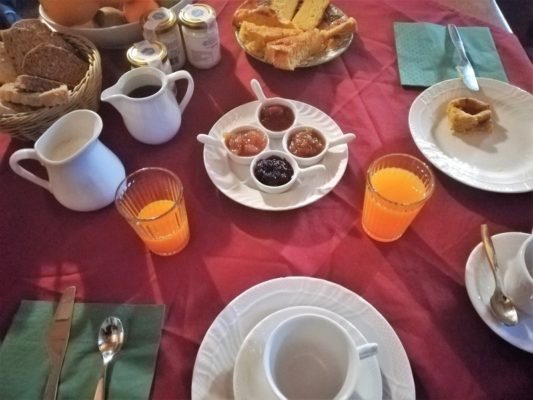
Breakfast at Agriturismo Il Gioco dell’Oca
After looking at different options, we opted to stay at Agriturismo Il Gioco dell’Oca.
This accommodation sits in a rural house on the outskirts of Barolo and is conveniently located near many points of interest in the area.
We were impressed by the attention to detail in the rooms, the fresh and genuine breakfast products, and the generosity and hospitality of Mrs. Raffaella.
We highly recommend it.
Here you can check the offers and availability of
Best Time to Visit
There’s no wrong time to visit the Langhe region.
In our opinion, the area maintains its charm throughout the year and the changing seasons only add unique characteristics that can cater to different tastes.
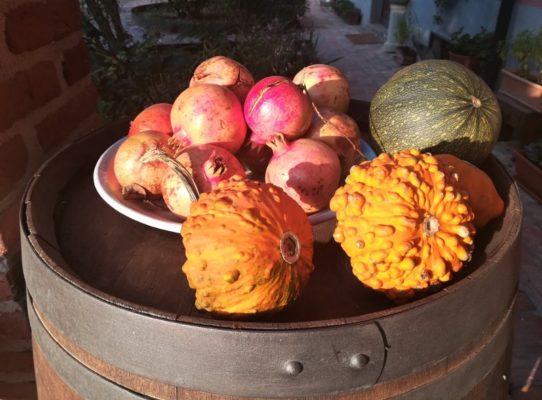
Autumn colors, Agriturismo Il Gioco dell’Oca
In fact, the Langhe is beautiful in every season. In winter, the hills are frequently covered in a blanket of snow, while in summer they are lush and green.
During the fall foliage season, the area is often blanketed in fog in the early morning.
We decided to visit it in the autumn, when the landscape is filled with bright and vibrant colors as nature changes its color palette.
It’s worth noting that autumn is considered high season for tourism in the Langhe.
Langhe Wines
The Piedmont region is known for producing high-quality wines that are cultivated with care and attention.
These wines are popular among enthusiasts and connoisseurs who appreciate and are willing to pay for excellence.
Let’s take a closer look at some of the notable wines of the Piedmont region.
Nebbiolo
Nebbiolo is the primary grape variety grown in the Langhe region and is the base for some of the most renowned red wines in Piedmont that are suitable for aging, including Barolo and Barbaresco.
The name “Nebbiolo” comes from the Italian word “nebbia,” which means “fog”, and perfectly describes the misty autumn mornings in the Langhe region.
Nebbiolo has a taste that ranges from dry to sweet and a ruby red color that tends towards garnet.
If it is not used as the base for producing Barolo or Barbaresco, it can be aged for up to 8 years.
The DOCG production area for Nebbiolo includes the territories of Barolo, Barbaresco, Roero, Ghemme, Gattinara, and Terre Alfieri.
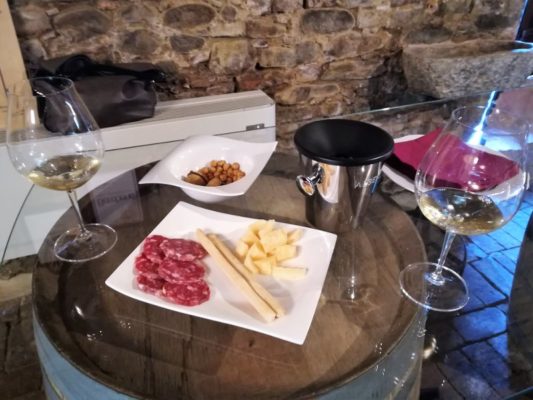
Wine tasting at Cascina Sòt
Barolo
Barolo is a red wine that is made from 100% pure Nebbiolo grapes and is highly sought after and renowned worldwide.
The story of Barolo is one of passion and perseverance, with contributions from the Marquises Falletti (particularly Juliette Colbert de Maulevrier, the wife of Marquis Carlo), General Francesco Staglieno, and French oenologist Louis Oudart.
The Count Camillo Benso di Cavour’s estates in Verduno, Pollenzo, and Grinzane were among the first to produce what would eventually become the wine of the House of Savoy.
Barolo must be aged for at least 38 months, 18 of which must be spent in oak barrels, starting on November 1st of the year of production.
The DOCG production area for Barolo is limited to the municipalities of Barolo, La Morra, Monforte d’Alba, Serralunga d’Alba, Grinzane Cavour, Castiglione Falletto, and Novello.
Only portions of the territories of Verduno, Cherasco, Roddi, and Diano d’Alba are included in the production area.
Barbaresco
Barbaresco is a red wine made from 100% pure Nebbiolo grapes. It has a deep ruby red color and a dry, velvety and harmonious taste.
The production area for Barbaresco covers only 650 hectares in the municipalities of Barbaresco, Neive, Treiso, and a small portion of San Rocco Seno d’Elvio in Alba.
It is one of the smallest DOCG production areas in Italy.
Barbaresco must be aged for a minimum of 26 months, 9 of which must be spent in oak barrels. After that, it can continue to age in the bottle for up to 25 years, if it is well preserved.
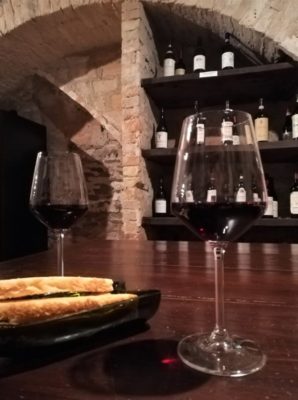
Tasting at Bottega dei 4 Vini, located in Neive
Dolcetto
Dolcetto is a native grape variety of Piedmont.
The vine grows quickly and matures early, so it is often grown in colder soils where Nebbiolo might have difficulty reaching full maturity.
The DOCG production area for Dolcetto is located in the municipalities of Diano d’Alba, Dogliani, and Ovada.
Dolcetto has an intense ruby red color and is generally considered a classic table wine, meant to be consumed young. For this reason, it is rare to find aged Dolcetto.
Nas-cëtta
Nas-cëtta is a native white grape variety that is grown in the Piedmont region, which is predominantly known for its red wines.
It has a semi-aromatic flavor and was almost forgotten for a time, but was rediscovered by producers in the municipality of Novello about 20 years ago.
Since 2010, Nas-cëtta has received the recognition of DOC Langhe Nas-cëtta from the municipality of Novello, which allows it to be produced only in the municipal territory using pure grapes.
If you’re interested in trying Nas-cëtta, you can visit the Bottega del Vino in Novello and participate in a tasting with three different types of Nas-cëtta.
Local Specialities
Agricultural products are often considered to be the true ambassadors of a region, and the Langhe region is home to some truly exceptional products.
Here are a few examples.
The White Truffle of Alba
The Langhe region, along with the neighboring regions of Roero and Monferrato, has a long history of producing high-quality truffles, both white and black.
Alba is widely known as the capital of white truffles, and the village of Roddi has earned the nickname “Borgo dei Tartufi,” or “Truffle Village”.
In the late 19th century, a local farmer named Antonio Monchiero founded the first university for truffle dogs, which is still in operation today, at the Castle of Roddi.
The castle also houses the International Cooking School of the White Truffle of Alba, a school that is not for professional purposes but rather aims to enhance the region’s tourist offerings.
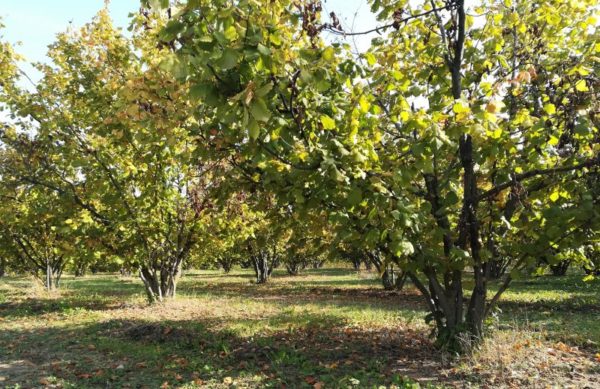
Hazelnut grove in the Langhe
The Tonda Gentile Hazelnut
The Alta Langa region, specifically in the municipalities of Cortemilia, Cravanzana, Murazzano, and Feisoglio, is known for producing some of the finest and most flavorful hazelnuts in the world.
The Tonda Gentile hazelnut of Piedmont is a smooth, fragrant, and flavorful fruit with special sensory qualities.
Hazelnuts are an integral part of the local cuisine and are used to prepare a variety of sweets such as bonet, stuffed peaches, chocolates, and cakes.
A trip to the Langhe, Best Things to Do
“Going to Langa” is a phrase often used by locals to describe visiting the region for the purpose of enjoying a glass of wine and socializing at a tavern.
It can also mean taking a break to watch a game of pétanque, a popular leisure activity played on a playground by locals after a day of work in the fields.
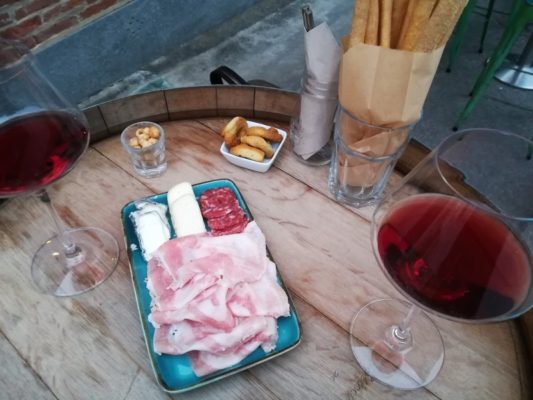
Tasting at Enoteca La Vite Turchese (Barolo)
Let’s find out together what other activities can be done in the Langhe.
Scenic Walks
If you’re looking to get in touch with nature and try some outdoor activities, the Langhe region is the perfect place for a vacation.
There are plenty of options to choose from, whether you prefer walking, horseback riding, mountain biking, or even eBiking.
One of the most famous routes for trekking in the area is the Bar to Bar, a network of paths that wind through Barbaresco and Barolo, crossing through the Alta Langa.
The route is 124 kilometers long and is divided into seven stages, suitable for both walking and off-road cycling.
The route takes you through low-traffic roads, dirt roads, headlands, and woods, offering stunning views along the way.
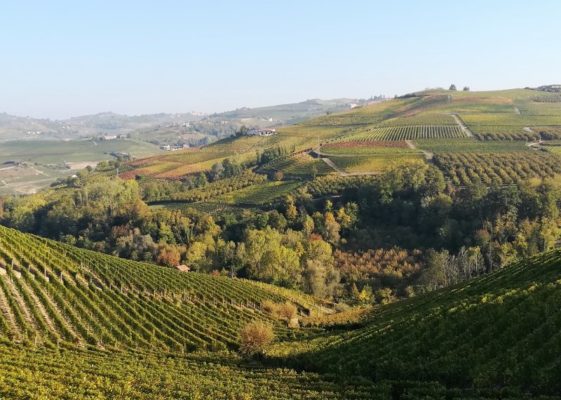
Vineyard landscape
As you travel along the Bar to Bar route, you’ll pass through small villages where you can stop to visit historical landmarks such as towers, castles, and museums, expanding your cultural knowledge along the way.
You’ll also find farms with cellars where you can take a break and enjoy some refreshment.
Keep in mind that some sections of the route include challenging climbs that are only suitable for those who are well-trained.
Another option for walking enthusiasts is the Albesi Trails, a series of six paths that pass through the hills on the outskirts of Alba. Each path has its own unique natural and cultural features.
Alba is also the birthplace of Beppe Fenoglio, a famous 20th century writer.
If you’re a fan of Fenoglio’s work “Il partigiano Johnny”, there are four itineraries dedicated to him in the city and its surroundings, featuring special information panels.
Wine Tasting
As mentioned before, the Langhe region is a great destination for those who want to have an immersive and experiential vacation.
One of the most popular activities in the area is visiting a winery and participating in a wine tasting.
In fact, many tourists and professionals come from overseas just for this experience.
No matter which village you visit, even the smallest ones, you’ll find municipal cellars, regional wine bars, and taverns to visit.
The countryside is also dotted with farms and wineries, which are great places to take a break and enjoy some refreshments.
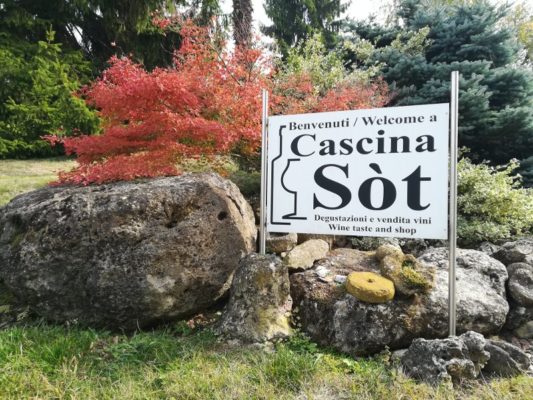
The garden of Cascina Sòt
One winery that is worth a visit is Cascina Sòt, located on the outskirts of Monforte d’Alba.
You can get there by taking a narrow road that branches off just outside the village and heads towards Barolo.
The name “Cascina Sòt” means “below the farm,” as it is located at the bottom of the hill.
The family-run company was founded in 1975 and cultivates its own vineyards, some of which are located in the famous Barolo crus and produce fine wine labels.
Unfortunately, we were not able to visit the winery during our trip as the workers were busy with the harvest, but we did have the opportunity to participate in a wine tasting.
Lorena, the host, led us on a sensory journey as we tasted six different types of wine and shared with us the values that drive their work, such as a sense of belonging and passion.
Langhe Cuisine
Langhe region restaurants tend to change their menus according to the seasonality of the products, with a focus on using local, fresh ingredients.
During our stay, we noticed that there were a few dishes that seemed to be staples on the menus of most restaurants in the region.
These dishes are considered to be typical of Langhe cuisine and include:
Starters:
- Veal with tuna sauce in the old way;
- Traditional Russian salad;
- Raw Fassona beef, sliced thin with a knife.
First Courses:
- Homemade egg tajarin (tagliolini) with porcini mushrooms, white truffle, or meat sauce;
- Ravioli del plin stuffed with meat or with butter and sage.
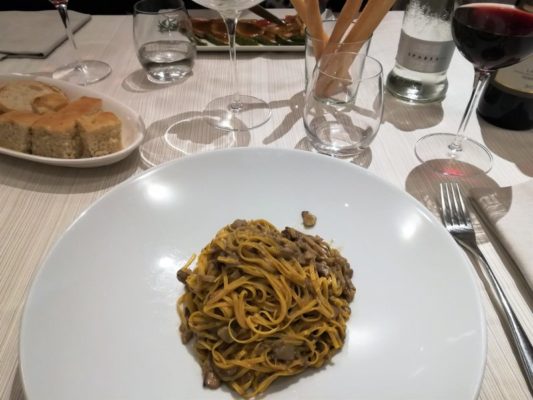
Tajarin with porcini mushrooms (L’Angolo di Rosina restaurant, Novello)
Second Courses:
- Veal stew with Barolo;
- Braised cheek with Nebbiolo;
- Tripe.
Cheeses:
- Robiola di Roccaverano and Murazzano;
- Assorted cow’s milk, sheep’s milk, and goat’s milk cheeses with sauces and jams.
Sweets:
- Bonet, a pudding made with chocolate, milk, macaroons, and eggs;
- Stuffed zabaione, a baked dessert made with amaretti and chocolate.
What to See in the Langhe
We were on vacation for three and a half days in the area. In our opinion, this was enough time to explore Alba and visit some of the most beautiful places in the Langhe, which are located on the gentle slopes of the hills.
There are fortified villages, castles, museums, country churches, and breathtaking landscapes to see, so there’s something for everyone.
In a future article, we plan to go into more detail about the specific places we visited and the activities we did during our trip.
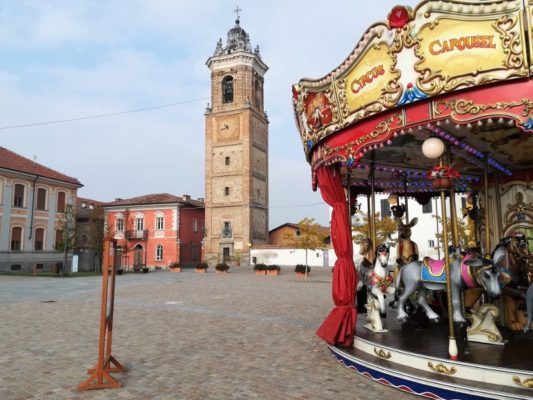
Castello a La Morra square
Itinerary Ideas
As fans of slow and sustainable tourism, we planned our itineraries with departure and arrival in Barolo, our base for the trip.
We tailored our itineraries to our own schedule, and were able to adjust them based on the weather and our own preferences.
We were lucky to have beautiful, sunny days at the end of October. Here are the three itineraries we took:
- Langa del Barolo – Itinerary n°1 Km 43
Barolo, Grinzane Cavour, Diano d’Alba, Sinio, Serralunga d’Alba, Monforte d’Alba, Barolo;
- Langa del Barolo – Itinerary n°2 Km 39
Barolo, Novello, La Morra, Pollenzo, Roddi, Barolo;
- Langa del Barbaresco – Itinerary n°3 Km 79
Barolo, San Rocco Seno d’Elvio, Madonna di Como, Treiso, Tre Stelle, Neive, Coazzolo, Barbaresco, Barolo.
Finally, we dedicated the other free hours to the visit of Barolo and Alba cities, where we have been twice.
In a future article, we will go into more detail about these itineraries, including descriptions of the villages, castles, and other activities we took part in.
UNESCO Landscapes
Since June 22, 2014, the wine landscapes of the Langhe-Roero and Monferrato have been recognized by UNESCO as World Heritage Sites.
This was a national record for wine landscapes, followed only in 2019 by the Prosecco Hills of Conegliano and Valdobbiadene.
The site is divided into six components of cultural and historical importance, including five distinct wine areas and a castle.
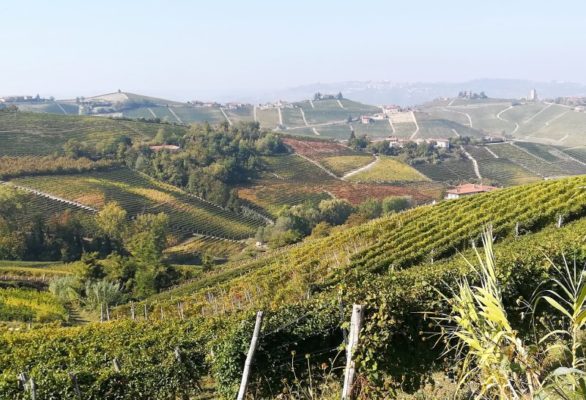
UNESCO World Heritage Site – wine landscape in the Langhe
Specifically, these are the Langa del Barolo, the Castle of Grinzane Cavour, the Colline del Barbaresco, Nizza Monferrato and Barbera, Canelli and Asti Spumante and finally the Monferrato degli Infernot.
The Association that takes care of its promotion following the dictates and guidelines of UNESCO was established in 2011 by the Piedmont Region and the three provinces involved (Cuneo, Asti and Alessandria).
Panoramic Viewpoints
The Bassa Langa landscape is characterized by gentle slopes formed by the combined efforts of nature and human intervention.
It features beautiful and captivating landscapes, with the towers of fortifications standing out in the distance.
The best way to explore this area is to take itinerant tours, leaving the main roads to take smaller, secondary roads.
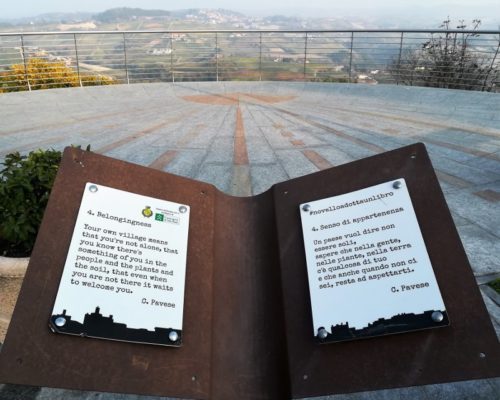
Novello belvedere
As you wind through the region, the landscape constantly changes, with an alternation of light and shadow that gives nature different appearances.
Taking advantage of the low traffic, we stopped several times along the side of the road to marvel at the stunning beauty around us.
In addition to the many natural lookouts, there are some particularly special vantage points that we recommend you seek out during your trip to the Langhe:
- the Unesco viewpoint of La Morra;
- the belvedere of Novello, located next to the castle;
- the tower of Barbaresco;
- the Unesco belvedere on the slopes of the Castle of Grinzane Cavour;
- the Unesco viewpoint at the base of the Neive Clock Tower;
David Tremlett Colorful Churches
The artist David Tremlett has left a lasting impact on the landscape of the Langhe region.
The British master, known for his wall drawings and brushstrokes applied with the palm of his hand, has created four works that have become popular destinations for tourists and the curious.
Brunate Chapel in La Morra
The church dedicated to the Santissima Madonna delle Grazie is located in the countryside of the small village of La Morra.
It can be reached either from Barolo or from La Morra. From the outskirts of Barolo, there is a well-marked dirt road that leads to the church.
From La Morra, the path is a bit bumpier and can be accessed by taking the road to Fontanazza and following the dirt track through the vineyards.
The church is a popular destination for tourists and there is often a lot of foot traffic.
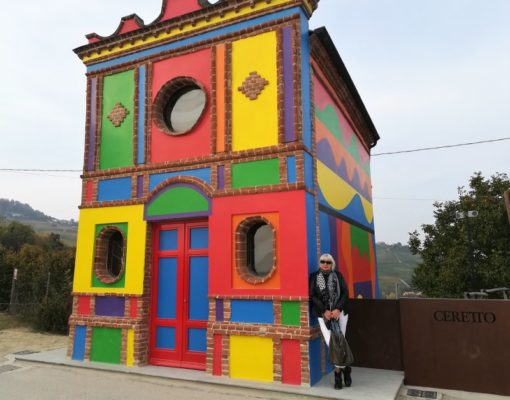
The Brunate or Barolo Chapel
Also known as the Chapel of Barolo or Brunate, after the name of the hill it sits on, this chapel was built in 1914 as a place of shelter for farmers during bad weather while working in the fields.
It fell into a state of neglect for several decades and was in poor condition, losing many of its original features.
In 1999, Bruno Ceretto, a well-known Barolo winemaker, commissioned the redevelopment of the church to the artists David Tremlett and Sol LeWitt.
LeWitt was responsible for restoring and decorating the exterior, while Tremlett adorned the interior.
The result is a small gem of contemporary art set in a beautiful natural environment.
The Church of Coazzolo
The 17th-century church dedicated to the Blessed Virgin of Mount Carmel is located in the municipality of Coazzolo and overlooks the Moscato hills.
To get there, you take a narrow road that winds through a picturesque countryside with beautiful panoramic views.
The church is located in a rural area, but it is well-signed.
It was restored by Silvano Stella in June 2017 and has become a reference point for the local community.
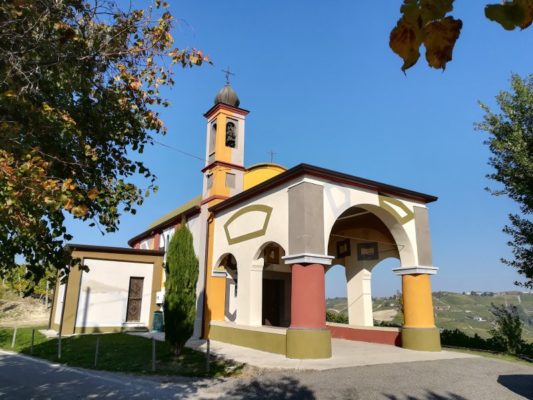
The church of Coazzolo, by David Tremlett
The church covers an area of about 300 square meters and is decorated with colors that reflect the surrounding environment: the yellow of the atrium, the Sienna earth for the body of the building and olive green for the sacristy.
Across the road, metal benches have been placed, offering a place to relax and enjoy the view.
A short distance away, there is a gently sloping path leading to the Vigna dei Pastelli, an avenue lined with vines and poles shaped like colored pencils.
The Chapel of Relais San Maurizio
The monastery of San Maurizio was founded in 1619 on the hills overlooking Santo Stefano Belbo by a community of Cistercian monks.
The monks from nearby Provence introduced grape cultivation and used some underground rooms of the monastery as a cellar.
After about two centuries, the monks left the structure, which was then sold to private owners. In 1997, the complex was purchased by its current owner, who converted it into the luxury accommodation facility, Relais San Maurizio.
In 2019, on the occasion of the 400th anniversary of the founding of the monastery, David Tremlett restored the interior walls of the chapel located on the hotel grounds.
Santo Stefano Belbo is also the birthplace of the Italian writer Cesare Pavese.
Per le Langhe
David Tremlett’s final “gift” to the Langhe region is located in Serravalle, a small village nestled among the woods and vineyards at an elevation of 762 meters.
In 2020, during the pandemic, he oversaw the redevelopment project of the former Oratory of San Michele.
Due to the lockdown, Tremlett was unable to travel to the site and instead sent the project to the mayor, Davide Falletto.
The work was created using Tremlett’s wall drawing technique by Ferruccio Dotta, a trusted collaborator, and Chinese artist Li Zhao.
Chris Bangle’s Giant Benches
The “giant benches” or “big benches” have become a popular attraction in the Langhe region, inviting visitors to feel like children again for a moment.
The first bench was created by American designer Chris Bangle, inspired by the classic benches found in public parks.
It was installed in the vineyard of his estate in Clavesana, in the province of Cuneo, where he and his wife Catherine have lived for several years.
The goal was simply to offer a unique “viewing position” from which to appreciate the landscape.
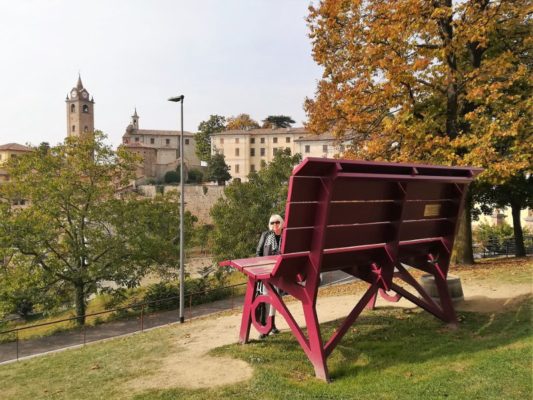
The giant purple bench (Monforte d’Alba)
The popularity of Chris Bangle’s giant benches has grown quickly, with numerous requests for new ones coming in.
Currently, over 180 of these unique structures have been built, not only in the Piedmont region of Italy, but also in other parts of the country and even abroad.
During our trip to the Langhe, we saw a few of these benches in the towns of La Morra, Monforte d’Alba, Neive, and Coazzolo.
However, there are many more scattered throughout the region, waiting to be discovered.
To learn more about the project and find the locations of the benches, you can visit the official website of the Big Bench Community Project.
0 Comments